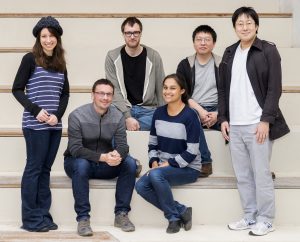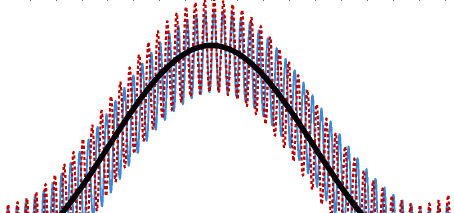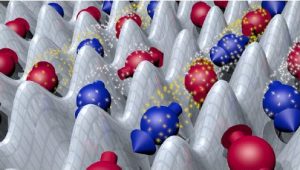Recent theoretical studies at Monash University bring us a step closer to realistic ‘quantum batteries’.
Such technology would depend on the energy difference offered by different quantum states, rather than on electrochemical changes, as is the case in traditional batteries.
Quantum batteries also offer potential for vastly better thermodynamic efficiency, and ultra-fast charging time.
The study, which was co-led by FLEET’s Meera Parish and Jesper Levinsen expanded earlier research into individual, isolated quantum batteries to consider a more-realistic, many-body system with intrinsic interactions. The researchers showed that interacting quantum batteries charge faster than isolated batteries.
Building better (quantum) batteries
With the proliferation of mobile computing comes a corresponding demand for ever-more efficient, ever-faster-charging batteries.
Quantum batteries present one possible future, with quantum entanglement (Einstein’s famous ‘spooky action at a distance) offering the potential for performance far exceeding (classical) technology.
The key to any ‘battery’ is the difference between its ‘charged’ and ‘uncharged’ state. In electrochemical batteries such as an iPhone’s lithium-ion pack, this represents a difference in stored electronic charge. In the Snowy River driven-hydro scheme, it’s the difference between water stored at higher or lower altitudes. In either case, that stored energy is available to be used to do work.
However ‘classical’ battery such as these examples operate at only a tiny fraction of theoretical thermodynamic limits.
In a quantum battery, such a difference would hinge on quantum entanglement: the quantum link between particles with identical quantum waveforms. A pair of entangled quantum batteries perform much better than one alone, in fact in theory the performance of a large-enough number of entangled quantum batteries could approach 100% of the thermodynamic limit.
The increased power of an entanglement-enhanced quantum battery theoretically allows quantum batteries to be charged much faster than their classical counterparts.
The work
Previous research into quantum batteries has assumed discrete, independent quantum systems that rely on global, many-body interactions in order to achieve a quantum advantage in charging power.
The recent Monash study instead considered more-realistic quantum batteries, with intrinsic many-body interactions.
Quantum spin chains were found to be a promising platform for quantum batteries. Spin chains consist of a number of spins arranged on a one-dimensional line and have served as an important and fruitful model for more complicated systems since the early days of quantum physics.
The researchers found that such quantum batteries, linked via spin-spin interactions charge faster than their non-interacting counterparts.
Interestingly, the researchers also discovered that this charging advantage was not due to (quantum nor classical) correlations, as has been the case in earlier work, but rather was due to the mean-field effect of interactions between the spins.
Furthermore in the Monash study, the batteries were charged by local fields, instead of the usual collective charging.
The work also displays how the energy structure of the quantum batteries can be constructed to provide ultra-fast charging.
This work demonstrates the merging of realistic condensed-matter systems with quantum thermodynamics, culminating in potentially realisable many-body quantum batteries.
It was also the first time the charging of batteries was assumed to be by locally-applied fields, instead of the usual collective charging.
The study, Spin-chain model of a many-body quantum battery, was co-led by Thao P. Le and published in Physical Review A in February 2018.
Funding and collaboration

Theory of Quantum Matter group at Monash University. From left to right: Emma Laird, Jesper Levinsen, Tom Kirk, Meera Parish, Zheyu Shi, and Shimpei Endo.
The research was funded by a grant from Samsung, part of a project to investigate next-generation, quantum batteries. The collaboration seeks to determine the microscopic structure that optimises charging and discharging power in each of several models. “This will lead to proof-of-principle experiments and a step closer to designing batteries that operate close to the fundamental limits imposed by Nature,” says Meera Parish.
The work was also supported through an Australian Research Council Future Fellowship Grant.
The collaboration with the Samsung Advanced Institute of Technology investigated quantum, many-body systems, aiming for battery designs with greater energy storage and higher charging power.
Non-equilibrium physics and FLEET
The forcing of a quantum battery into a new, ‘charged’ state represents an example of non-equilibrium physics, in which systems are ‘forced’ out of equilibrium into a temporary state.
It is a relatively new, and exciting field, and a paradigm shift in material engineering.
At FLEET, non-equilibrium mechanisms are pursued by researchers in the Centre’s Research theme 3, light-transformed materials, with the aim of achieving zero-resistance paths for electrical current, as part of the Centre’s mission to develop a new generation of ultra-low energy electronics.
For example, short, intense bursts of light can be used to temporarily force matter to adopt a new, distinct topological state or to shift into a superfluid state.
The forced state achieved is only temporary, but researchers learn an enormous amount about the fundamental physics of topological insulators and superfluids as they observe the material shifting between natural and forced states, over a period of several microseconds.
Meera Parish and Jesper Levinsen’s research within FLEET’s Research theme 3 seeks understanding and control of interactions between particles in quantum matter, including:
- Differences between systems comprising only a few particles, and systems comprising many particles
- Effects of constraining the system to 1D or 2D
- Behaviour of quasiparticles within the system.
FLEET is an Australian Research Council-funded research centre bringing together over a hundred Australian and international experts to develop a new generation of ultra-low energy electronics.
The Theory of Quantum Matter group is currently advertising for a PhD position, studying the physics of ultracold atomic gases.
Further details
- A/Prof Meera Parish meera.parish@monash.edu
- Monash University Theory of Quantum Matter group physics.monash.edu
- FLEET org.au
- Social media @FLEETCentre
- FLEET contact Errol Hunt media@fleet.org.au





